
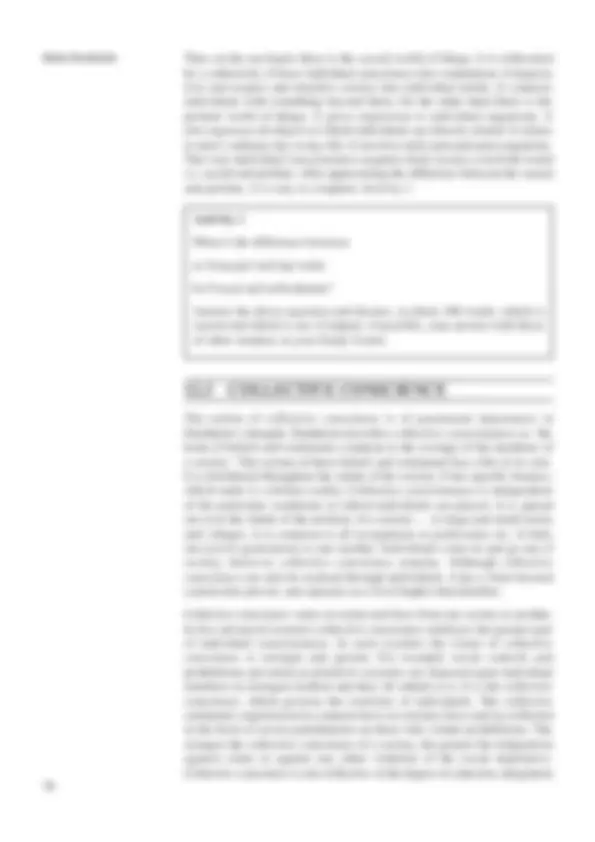

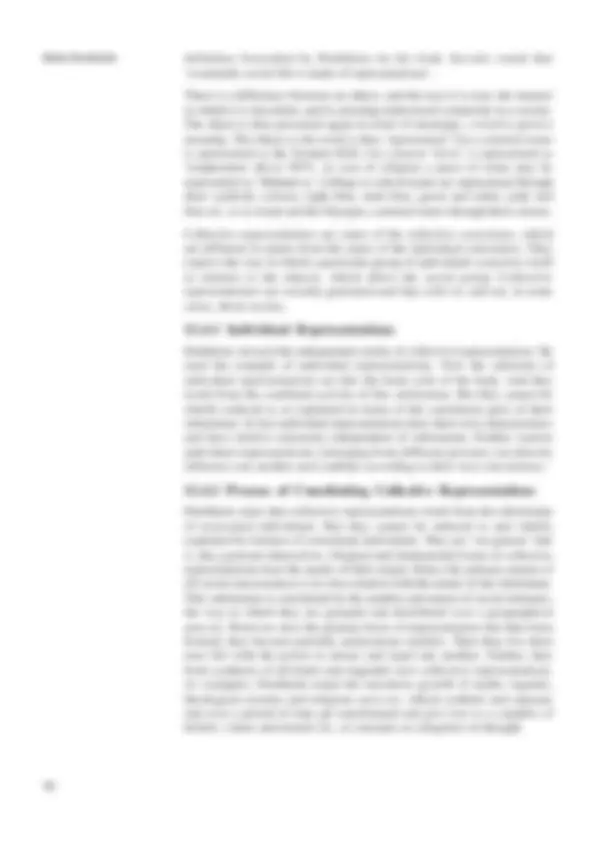
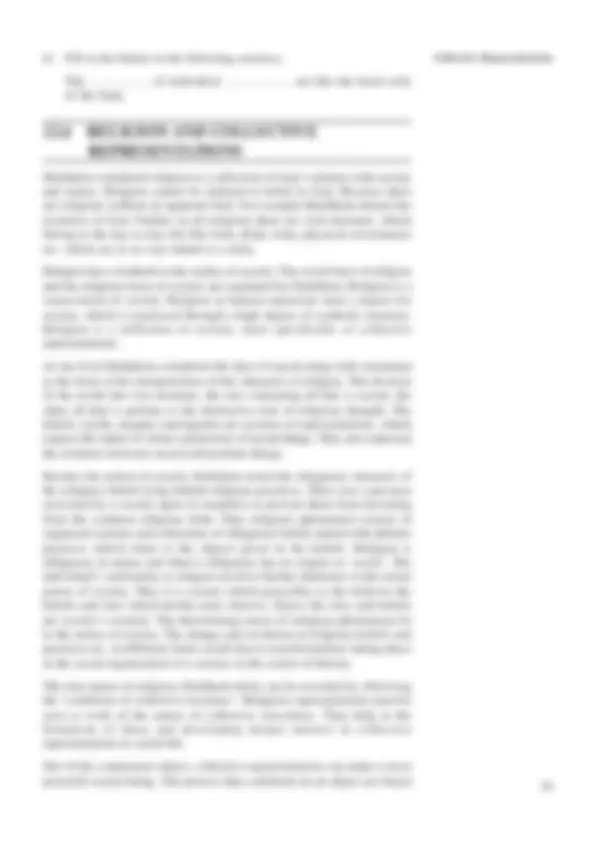
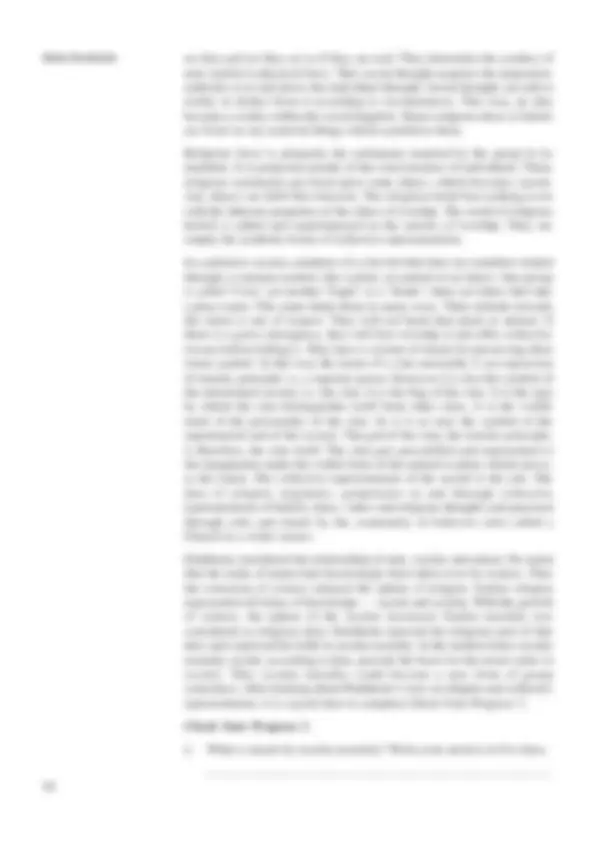
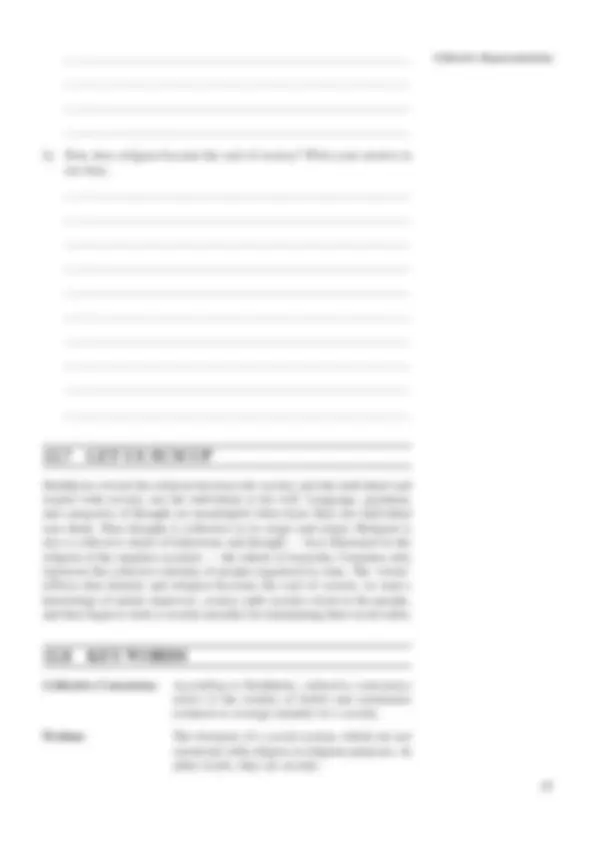


Study with the several resources on Docsity

Earn points by helping other students or get them with a premium plan


Prepare for your exams
Study with the several resources on Docsity

Earn points to download
Earn points by helping other students or get them with a premium plan
Community
Ask the community for help and clear up your study doubts
Discover the best universities in your country according to Docsity users
Free resources
Download our free guides on studying techniques, anxiety management strategies, and thesis advice from Docsity tutors
Emile Durkheim's theory explores the relationship between society and individual consciousness, focusing on the concept of collective conscience and collective representations. Society shapes individual consciousness, imposing its collectivity and moral authority. Collective conscience is the common body of beliefs and sentiments among society members, independent of individual existence. Collective representations are socially generated states of collective conscience, expressing society's nature and values. Religion is an essential aspect of collective representations, reflecting man's relation with society and nature.
Typology: Lecture notes
1 / 12

This page cannot be seen from the preview
Don't miss anything!







Emile Durkheim
12.0 Objectives 12.1 Introduction 12.2 Society and Individual Consciousness 12.3 Collective Conscience 12.4 Collective Representations 12.4.0 Collective Representation—Definition 12.4.1 Individual Representations 12.4.2 Process of Constituting Collective Representations 12.5 Cognition and Collective Representation 12.6 Religion and Collective Representation 12.7 Let Us Sum Up 12.8 Keywords 12.9 Further Reading 12.10 Specimen Answers to Check Your Progress
By the time you complete the study of this Unit, you should be able to
z explain the relation between society and individual consciousness
z discuss Durkheim’s concept of ‘collective conscience’
z describe the meanings of ‘collective representations’
z explain the ‘collective’ nature of ‘concepts’ or ‘categories of thought’, and
z illustrate collective representations through religion.
In Unit 10 you have already learnt about Durkheim’s break with philosophy. You have also studied that he made efforts to raise sociology to the status of science. Now we come to the central theme of Durkheimian thought: the relation between individuals and collectivity. Durkheim wanted to develop a scientific comprehension of this relation in its various forms. However, he was not satisfied with all earlier social theories, which considered ‘individual’ as their starting-point. He rejected theories of society built upon the ‘will’, ‘desire’ or ‘volition’ of the individual and held that scientific understanding of all social phenomena must emerge from the collective nature of a social group, community or society.
In order to explain Durkheim’s concept of collective representations, this^ Collective Representations unit covers five main areas of discussion. First, it tells you about society and individual consciousness. Then it mentions the concept of collective conscience. Next it discusses at length the main theme i.e. collective representations. Lastly, it speaks about collective representations in terms of cognition and religion.
Society has a nature, which is peculiar to itself. It is different from individual nature. Society pursues ends which are special to it. The compulsion of collective existence is such that individuals must forget their particular interests. Individuals must submit to some sort of inconvenience or sacrifice without which social life would be impossible. Thus society imposes upon individuals the nature of its collectivity. For example, at every moment in our life we are obliged to submit ourselves to the rules of conduct or behaviour, which we have neither made nor desired. Such rules of conduct are sometimes even in opposition to individual’s instincts and interests. However, we are supposed to obey and follow them. For instance, you may want to lead a completely care free life, without work, studies or family responsibilities. But society forces you to behave in a responsible manner and fulfil your various obligations. In this process, the special reality of society moulds the thinking, acting and consciousness of an individual.
Society exercises the moral authority over individuals. This moral authority provides society venerable respect. The ideas, beliefs, emotions etc. which society imposes upon individuals are marked out for respect. Since such ideas, beliefs and moral codes etc. are upheld by the collectivity, an individual breach is liable to invite societal action or punishment. Thus everything which is good for the health of society is cultivated by it as something sacred. Religious dogma, totemic symbols or modem flag etc. are all sacred things. They inspire in the individual at once a feeling of awe and reverence. In opposition to sacred things there are profane ones. Profane things are not accorded similar reverence as given to sacred ones. Moreover society keeps profane things apart from sacred things. Durkheim held that sacred things are those, which the interdictions protect and isolate. Profane things are those to which respect is denied and at times people are told to keep a distance from them. Finally there are always rules of conduct, which prescribe how men should behave in relation to sacred things.
Society does not confine itself to demanding sacrifices or efforts from individuals. It does not act upon individuals wholly from without. Society exists in and through individual consciousness. Hence societal force must also penetrate individuals and organise itself within them. Thus it becomes an integral part of individual consciousness. This is the reason that societal beliefs, morals and rules etc. are elevated and magnified by individuals. Their source of origin cannot be traced or attributed to single individuals. Rather their perpetuation lies in collective existence. However such beliefs, ideas, emotions become a permanent part of individual consciousness.
or solidarity of a society. In primitive societies, collective conscience is^ Collective Representations strongest and all-embracing. However, in advanced societies there occurs a greater differentiation of individuals. Everyone becomes more and more free to believe, to desire and to act according to one’s own or one’s group preferences in a large number of circumstances. Thus the sphere of influence of collective conscience is reduced. There also occurs a weakening of collective reactions against violations of prohibitions etc.
The concept of collective conscience was originally used and developed by Durkheim in his first major work i.e. The Division of Labour in Society (1895). The strength of collective conscience will be later described through the nature of social solidarity which forms part of Unit 13. In his later works, Durkheim developed the concept of ‘collective representations’, which had greater theoretical potential.
Check Your Progress 1
i) Explain in simple words, in five lines, your understanding of Durkheim’s views on the relation between ‘society’ and ‘individual consciousness’.
...................................................................................................................
...................................................................................................................
...................................................................................................................
...................................................................................................................
...................................................................................................................
ii) Define, in three lines, the concept of collective conscience given by Durkheim.
...................................................................................................................
...................................................................................................................
...................................................................................................................
Durkheim looks into the role of collective beliefs and sentiments and especially of morality and religion in all societies. How are they inculcated and how do they exercise control over society? How are they affected by society and how in turn do they affect other features of social life? How do collective beliefs and sentiments change during different stages of a society’s development? To prepare for such answers Durkheim used the French term ‘representations collective’, which translated into English is ‘collective representations’.
The concept of ‘collective representations’ is a major contribution of Durkheim’s social theory. In fact, Durkheim’s later work (1897 onwards) can be seen as a systematic study of ‘collective representations’. Initial
Emile Durkheim (^) definition forwarded by Durkheim (in his book Suicide ) stated that
‘essentially social life is made of representations’.
There is a difference between an object, and the way it is seen, the manner in which it is described, and its meaning understood commonly in a society. The object is thus presented again in terms of meanings, a word is given a meaning. The object or the word is thus ‘represented’; for a scientist water is represented as the formula H2O, for a doctor ‘fever’ is represented as ‘temperature above 99°F., in case of religion a piece of stone may be represented as ‘Mahadeva’. College or school teams are represented through their symbolic colours, light blue, dark blue, green and white, pink and blue etc. or in Asiad and the Olympics, national teams through their colours.
Collective representations are states of the collective conscience, which are different in nature from the states of the individual conscience. They express the way in which a particular group of individuals conceives itself in relation to the objects, which affect the social group. Collective representations are socially generated and they refer to, and are, in some sense, about society.
Durkheim stressed the independent reality of collective representations. He used the example of individual representations. Now the substrata of individual representations are like the brain cells of the body. And they result from the combined activity of this substratum. But they cannot be wholly reduced to or explained in terms of the constituent parts of their substratum. In fact individual representations have their own characteristics and have relative autonomy independent of substratum. Further various individual representations (emerging from different persons) can directly influence one another and combine according to their own convenience.
Durkheim states that collective representations result from the substratum of associated individuals. But they cannot be reduced to and wholly explained by features of constituent individuals. They are ‘sui generis’ that is, they generate themselves. Original and fundamental forms of collective representations bear the marks of their origin. Hence the primary matter of all social consciousness is in close relation with the nature of the substratum. This substratum is constituted by the number and nature of social elements, the way in which they are grouped and distributed over a geographical area etc. However once the primary basis of representations has thus been formed, they become partially autonomous realities. Then they live their own life with the power to attract and repel one another. Further, they form synthesis of all kinds and engender new collective representations. As examples, Durkheim noted the enormous growth of myths, legends, theological systems and religious sects etc. which combine and separate and over a period of time get transformed and give rise to a complex of beliefs, values and morals etc. or concepts or categories of thought.
Emile Durkheim (^) and passed to other individuals. However, conversation and all intellectual
communications between individuals are an exchange of concepts. Thus concepts and categories of thought are essentially impersonal representations. It is through these that cognition structure and human intelligence communicates.
Concepts are the work of the community. They bear the mark of no particular mind. They spring from the associational nature of a group or collectivity. Categories of thought are more stable than sensations or images. The reason is that collective representations are more stable than the individual representations. Only slight changes in environment can affect an individual consciousness, however, any change in the mental status of a society can only be effected through events of extreme gravity, e.g. revolutions or political movements, such as the National Movement for Independence.
Language and consequently the system of concepts, which it translates, is the product of collective elaboration. What it expresses is the manner in which society as a whole represents the facts of collective experience. The ideas which correspond to the diverse elements of language are thus collective representations.
Concepts are collective representations and belong to the whole society. If they belong to the whole social group, it is not because they represent the average of the corresponding individual representations. Because in that case collective representations would be poorer than individual representations in intellectual content. However, as a matter of fact, collective representations contain much more that surpasses the knowledge of the average individual.
Concepts as collective representations are more or less general ideas prevalent in a society. They express categories and classes rather than particular objects, because unique and variable characteristics of things only rarely interest society. Collective representations are the work of society and they are enriched by the societal experience. For example in the context of modern nation states, collective representations are social facts located in the constitutions, the national flag, and the national anthem. Before proceeding to the next sub-section let us complete Check Your Progress 2!
Check Your Progress 2
i) We mention some of the concepts used in Sociology, for example socialisation, community, social system. Mention five other concepts in the subject.
a)
b)
c)
d)
e)
ii) Fill in the blanks in the following sentence.^ Collective Representations
The …………… of individual …………….. are like the brain cells of the body.
Durkheim considered religion as a reflection of man’s relation with society and nature. Religion cannot be reduced to belief in God. Because there are religions without an apparent God. For example Buddhism denied the existence of God. Further, in all religions there are vital elements, which belong to the day-to-day life like food, drink, body, physical environment etc. which are in no way linked to a deity.
Religion has a foothold in the reality of society. The social basis of religion and the religious basis of society are explained by Durkheim. Religion is a consecration of society. Religion at bottom represents man’s respect for society, which is expressed through a high degree of symbolic intensity. Religion is a reflection of society, more specifically of collective representations.
At one level Durkheim considered the idea of sacred along with communal as the basis of his interpretation of the character of religion. The division of the world into two domains, the one containing all that is sacred, the other all that is profane is the distinctive trait of religious thought. The beliefs, myths, dogmas and legends are systems of representations, which express the nature of virtues and powers of sacred things. They also represent the relations between sacred and profane things.
Besides the notion of sacred, Durkheim noted the obligatory character of the religious beliefs lying behind religious practices. There was a pressure exercised by a society upon its members to prevent them from deviating from the common religious faith. Thus religious phenomena consist of organised systems and collections of obligatory beliefs united with definite practices which relate to the objects given in the beliefs. Religion is obligatory in nature and what is obligatory has its origins in ‘social’. The individual’s conformity to religion involves his/her deference to the moral power of society. Thus it is society which prescribes to the believer the beliefs and rites which he/she must observe. Hence the rites and beliefs are society’s creation. The determining causes of religious phenomena lie in the nature of society. The change and evolution in religious beliefs and practices etc. in different forms result due to transformations taking place in the social organisation of a society in the course of history.
The true nature of religion, Durkheim held, can be revealed by observing the ‘conditions of collective existence’. Religious representations must be seen as work of the nature of collective conscience. They help in the formation of ideas and developing deeper interest in collective representations in social life.
Out of the commonest object, collective representations can make a most powerful sacred being. The powers thus conferred on an object are based
...................................................................................................................^ Collective Representations
...................................................................................................................
...................................................................................................................
...................................................................................................................
ii) How does religion become the soul of society? Write your answer in ten lines.
...................................................................................................................
...................................................................................................................
...................................................................................................................
...................................................................................................................
...................................................................................................................
...................................................................................................................
...................................................................................................................
...................................................................................................................
...................................................................................................................
...................................................................................................................
Durkheim viewed the relation between the society and the individual and started with society, not the individual or his will. Language, grammar, and categories of thought are meaningful when more than one individual uses them. Thus thought is collective in its usage and origin. Religion is also a collective mode of behaviour and thought — best illustrated in the religion of the simplest societies — the tribals of Australia. Common cults represent the collective identity of people organised in clans. The ‘totem’ reflects that identity and religion becomes the soul of society. As man’s knowledge of nature improves, science adds secular vision to the people, and they begin to look to secular morality for maintaining their social order.
Collective Conscience According to Durkheim, collective conscience refers to the totality of belief and sentiments common to average member of a society.
Profane The elements of a social system, which are not connected with religion or religious purposes. In other words, they are secular.
Emile Durkheim (^) Sacred Those elements of a social system which relate
to religion or are set apart for the worship of deity.
Solidarity It refers to unity (as of a group or class) that is based on or produces community of interests, objectives and standards.
Lukes, S. 1973. Emile Durkheim, His Life and Work: A Historical and Critical Study. Allen Lane and The Penguin Press: London.
Nisbet, R.A. 1974. The Sociology of Emile Durkheim Oxford University Press: New York.
Raymond, A. 1979. (reprint). Main Currents in Sociological Thought-11. Penguin:
Harmondsworth. See Emile Durkheim, pp. 21-108.
Check Your Progress 1
i) Society has an existence of its own which is different from the collective existence of individuals in society. Society imposes certain restrictions on individual consciousness and compels them to conform to social rules of conduct or behaviour. Thus, the compulsion of collective existence due to which individuals conform to social rules is such that individual interests get subordinated to the collective interests of society.
ii) According to Durkheim, collective conscience refers to the body of beliefs and sentiments, which are found in the average members of a society. It is independent of the particular existence of individuals in society.
Check Your Progress 2
i) a) function, b) structure, c) stratification, d) social change, and e) conflict
ii) substratum, representations
Check Your Progress 3
i) Moral force controls individual’s behaviour. This force makes a person obey the social commands or norms. In earlier societies this force was sanctioned through religion. In modem societies, religious force has become weaker. Yet society controls a member’s behaviour. Morality continues to be there, but is now delinked from religion. Such morality is secular.